How to Resign - What You Need to Know
Liz Jones • March 25, 2019
Even though you have given it a lot of thought, scheduled interviews and have long ago made the decision to search for a new job, when it comes to the crunch, resigning can be stressful. And as we know, stress can manifest itself in numerous ways. Here are a few tips:
You must resign in writing and sign your resignation letter. This is the ideal, rather than an email. You need to have re read your employment contract to confirm your contractual obligations, such as how much notice is required. Usually, this follows your pay cycle (ie if you’re paid monthly, then it’s usually 4 weeks or a month’s notice). The exception would be if you are still in your probation period and you may only be required to provide one week’s notice.
If you don’t give the contracted amount of notice, then your employer does not have to pay out your notice period. If you do give the correct amount of notice and then you choose to leave earlier, then your employer does not have to pay out your notice, either. However, if you give the correct amount of notice and your employer chooses to wrap you up earlier, then they do have to pay your out notice period.
As mentioned, it can be a stressful time, but leave any negativity at the door. There is nothing to be gained by being combative in your resignation meeting with your manager. People leave their jobs and employers all the time. It’s a business decision, don’t make it personal. I always remind people that the industry within which you work is always small; people know a lot of people. You just never know when your paths will cross again, or your kids all end up at the same school. I’ve seen it happen.
As an employee, there are two times when you are remembered most clearly. When you start a new job and when you leave it!
Find the job you love I Find the right talent
Get in touch with people2people
Australia
I United Kingdom
In business since 2002 in Australia, NZ, and the United Kingdom, people2people is an award-winning recruitment agency with people at our heart. With over 12 offices, we specialise in accounting and finance, business support, education, executive, government, HR, legal, marketing and digital, property, sales, supply chain, and technology sectors. As the proud recipients of the 2024 Outstanding Large Agency and Excellence in Candidate Care Awards, we are dedicated to helping businesses achieve success through a people-first approach.
Recent articles









